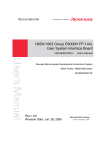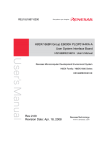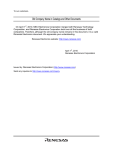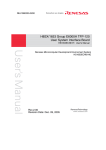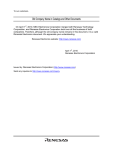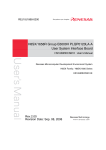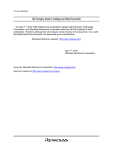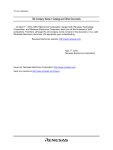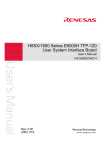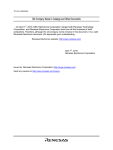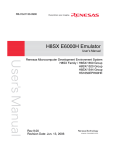Download Renesas FP-144L Technical information
Transcript
To our customers, Old Company Name in Catalogs and Other Documents On April 1st, 2010, NEC Electronics Corporation merged with Renesas Technology Corporation, and Renesas Electronics Corporation took over all the business of both companies. Therefore, although the old company name remains in this document, it is a valid Renesas Electronics document. We appreciate your understanding. Renesas Electronics website: http://www.renesas.com April 1st, 2010 Renesas Electronics Corporation Issued by: Renesas Electronics Corporation (http://www.renesas.com) Send any inquiries to http://www.renesas.com/inquiry. Notice 1. 2. 3. 4. 5. 6. 7. All information included in this document is current as of the date this document is issued. Such information, however, is subject to change without any prior notice. Before purchasing or using any Renesas Electronics products listed herein, please confirm the latest product information with a Renesas Electronics sales office. Also, please pay regular and careful attention to additional and different information to be disclosed by Renesas Electronics such as that disclosed through our website. Renesas Electronics does not assume any liability for infringement of patents, copyrights, or other intellectual property rights of third parties by or arising from the use of Renesas Electronics products or technical information described in this document. No license, express, implied or otherwise, is granted hereby under any patents, copyrights or other intellectual property rights of Renesas Electronics or others. You should not alter, modify, copy, or otherwise misappropriate any Renesas Electronics product, whether in whole or in part. Descriptions of circuits, software and other related information in this document are provided only to illustrate the operation of semiconductor products and application examples. You are fully responsible for the incorporation of these circuits, software, and information in the design of your equipment. Renesas Electronics assumes no responsibility for any losses incurred by you or third parties arising from the use of these circuits, software, or information. When exporting the products or technology described in this document, you should comply with the applicable export control laws and regulations and follow the procedures required by such laws and regulations. You should not use Renesas Electronics products or the technology described in this document for any purpose relating to military applications or use by the military, including but not limited to the development of weapons of mass destruction. Renesas Electronics products and technology may not be used for or incorporated into any products or systems whose manufacture, use, or sale is prohibited under any applicable domestic or foreign laws or regulations. Renesas Electronics has used reasonable care in preparing the information included in this document, but Renesas Electronics does not warrant that such information is error free. Renesas Electronics assumes no liability whatsoever for any damages incurred by you resulting from errors in or omissions from the information included herein. Renesas Electronics products are classified according to the following three quality grades: “Standard”, “High Quality”, and “Specific”. The recommended applications for each Renesas Electronics product depends on the product’s quality grade, as indicated below. You must check the quality grade of each Renesas Electronics product before using it in a particular application. You may not use any Renesas Electronics product for any application categorized as “Specific” without the prior written consent of Renesas Electronics. Further, you may not use any Renesas Electronics product for any application for which it is not intended without the prior written consent of Renesas Electronics. Renesas Electronics shall not be in any way liable for any damages or losses incurred by you or third parties arising from the use of any Renesas Electronics product for an application categorized as “Specific” or for which the product is not intended where you have failed to obtain the prior written consent of Renesas Electronics. The quality grade of each Renesas Electronics product is “Standard” unless otherwise expressly specified in a Renesas Electronics data sheets or data books, etc. “Standard”: 8. 9. 10. 11. 12. Computers; office equipment; communications equipment; test and measurement equipment; audio and visual equipment; home electronic appliances; machine tools; personal electronic equipment; and industrial robots. “High Quality”: Transportation equipment (automobiles, trains, ships, etc.); traffic control systems; anti-disaster systems; anticrime systems; safety equipment; and medical equipment not specifically designed for life support. “Specific”: Aircraft; aerospace equipment; submersible repeaters; nuclear reactor control systems; medical equipment or systems for life support (e.g. artificial life support devices or systems), surgical implantations, or healthcare intervention (e.g. excision, etc.), and any other applications or purposes that pose a direct threat to human life. You should use the Renesas Electronics products described in this document within the range specified by Renesas Electronics, especially with respect to the maximum rating, operating supply voltage range, movement power voltage range, heat radiation characteristics, installation and other product characteristics. Renesas Electronics shall have no liability for malfunctions or damages arising out of the use of Renesas Electronics products beyond such specified ranges. Although Renesas Electronics endeavors to improve the quality and reliability of its products, semiconductor products have specific characteristics such as the occurrence of failure at a certain rate and malfunctions under certain use conditions. Further, Renesas Electronics products are not subject to radiation resistance design. Please be sure to implement safety measures to guard them against the possibility of physical injury, and injury or damage caused by fire in the event of the failure of a Renesas Electronics product, such as safety design for hardware and software including but not limited to redundancy, fire control and malfunction prevention, appropriate treatment for aging degradation or any other appropriate measures. Because the evaluation of microcomputer software alone is very difficult, please evaluate the safety of the final products or system manufactured by you. Please contact a Renesas Electronics sales office for details as to environmental matters such as the environmental compatibility of each Renesas Electronics product. Please use Renesas Electronics products in compliance with all applicable laws and regulations that regulate the inclusion or use of controlled substances, including without limitation, the EU RoHS Directive. Renesas Electronics assumes no liability for damages or losses occurring as a result of your noncompliance with applicable laws and regulations. This document may not be reproduced or duplicated, in any form, in whole or in part, without prior written consent of Renesas Electronics. Please contact a Renesas Electronics sales office if you have any questions regarding the information contained in this document or Renesas Electronics products, or if you have any other inquiries. (Note 1) “Renesas Electronics” as used in this document means Renesas Electronics Corporation and also includes its majorityowned subsidiaries. (Note 2) “Renesas Electronics product(s)” means any product developed or manufactured by or for Renesas Electronics. User’s Manual H8SX/1663 Group E6000H FP-144L User System Interface Board HS1664ECH61H User’s Manual Renesas Microcomputer Development Environment System H8SX Family / H8SX/1600 Series HS1664ECH61HE Rev.1.00 2006.06 Keep safety first in your circuit designs! 1. Renesas Technology Corp. puts the maximum effort into making semiconductor products better and more reliable, but there is always the possibility that trouble may occur with them. Trouble with semiconductors may lead to personal injury, fire or property damage. Remember to give due consideration to safety when making your circuit designs, with appropriate measures such as (i) placement of substitutive, auxiliary circuits, (ii) use of nonflammable material or (iii) prevention against any malfunction or mishap. Notes regarding these materials 1. These materials are intended as a reference to assist our customers in the selection of the Renesas Technology Corp. product best suited to the customer's application; they do not convey any license under any intellectual property rights, or any other rights, belonging to Renesas Technology Corp. or a third party. 2. Renesas Technology Corp. assumes no responsibility for any damage, or infringement of any thirdparty's rights, originating in the use of any product data, diagrams, charts, programs, algorithms, or circuit application examples contained in these materials. 3. All information contained in these materials, including product data, diagrams, charts, programs and algorithms represents information on products at the time of publication of these materials, and are subject to change by Renesas Technology Corp. without notice due to product improvements or other reasons. It is therefore recommended that customers contact Renesas Technology Corp. or an authorized Renesas Technology Corp. product distributor for the latest product information before purchasing a product listed herein. The information described here may contain technical inaccuracies or typographical errors. Renesas Technology Corp. assumes no responsibility for any damage, liability, or other loss rising from these inaccuracies or errors. Please also pay attention to information published by Renesas Technology Corp. by various means, including the Renesas Technology Corp. Semiconductor home page (http://www.renesas.com). 4. When using any or all of the information contained in these materials, including product data, diagrams, charts, programs, and algorithms, please be sure to evaluate all information as a total system before making a final decision on the applicability of the information and products. Renesas Technology Corp. assumes no responsibility for any damage, liability or other loss resulting from the information contained herein. 5. Renesas Technology Corp. semiconductors are not designed or manufactured for use in a device or system that is used under circumstances in which human life is potentially at stake. Please contact Renesas Technology Corp. or an authorized Renesas Technology Corp. product distributor when considering the use of a product contained herein for any specific purposes, such as apparatus or systems for transportation, vehicular, medical, aerospace, nuclear, or undersea repeater use. 6. The prior written approval of Renesas Technology Corp. is necessary to reprint or reproduce in whole or in part these materials. 7. If these products or technologies are subject to the Japanese export control restrictions, they must be exported under a license from the Japanese government and cannot be imported into a country other than the approved destination. Any diversion or reexport contrary to the export control laws and regulations of Japan and/or the country of destination is prohibited. 8. Please contact Renesas Technology Corp. for further details on these materials or the products contained therein. IMPORTANT INFORMATION READ FIRST • READ this user's manual before using this user system interface board. • KEEP the user's manual handy for future reference. Do not attempt to use the user system interface board until you fully understand its mechanism. User System Interface Board: Throughout this document, the term "user system interface board" shall be defined as the following product produced only by Renesas Technology Corp. excluding all subsidiary products. • User system interface board (HS1664ECH61H) The user system or a host computer is not included in this definition. Purpose of the User System Interface Board: This user system interface board is for connecting the evaluation chip board and user system. This user system interface board must only be used for the above purpose. Improvement Policy: Renesas Technology Corp. (including its subsidiaries, hereafter collectively referred to as Renesas) pursues a policy of continuing improvement in design, performance, functions, and safety of the user system interface board. Renesas reserves the right to change, wholly or partially, the specifications, design, user's manual, and other documentation at any time without notice. Target User of the User System Interface Board: This user system interface board should only be used by those who have carefully read and thoroughly understood the information and restrictions contained in the user's manual. Do not attempt to use the user system interface board until you fully understand its mechanism. It is highly recommended that first-time users be instructed by users that are well versed in the operation of the user system interface board. I LIMITED WARRANTY Renesas warrants its user system interface boards to be manufactured in accordance with published specifications and free from defects in material and/or workmanship. Renesas will repair or replace any user system interface boards determined to be defective in material and/or workmanship. User system interface boards are wearing parts which Renesas will not repair or replace if damaged and/or worn through use. The foregoing shall constitute the sole remedy for any breach of Renesas’ warranty. This warranty extends only to you, the original Purchaser. It is not transferable to anyone who subsequently purchases the user system interface board from you. Renesas is not liable for any claim made by a third party or made by you for a third party. DISCLAIMER RENESAS MAKES NO WARRANTIES, EITHER EXPRESS OR IMPLIED, ORAL OR WRITTEN, EXCEPT AS PROVIDED HEREIN, INCLUDING WITHOUT LIMITATION THEREOF, WARRANTIES AS TO MARKETABILITY, MERCHANTABILITY, FITNESS FOR ANY PARTICULAR PURPOSE OR USE, OR AGAINST INFRINGEMENT OF ANY PATENT. IN NO EVENT SHALL RENESAS BE LIABLE FOR ANY DIRECT, INCIDENTAL OR CONSEQUENTIAL DAMAGES OF ANY NATURE, OR LOSSES OR EXPENSES RESULTING FROM ANY DEFECTIVE USER SYSTEM INTERFACE BOARD, THE USE OF ANY USER SYSTEM INTERFACE BOARD, OR ITS DOCUMENTATION, EVEN IF ADVISED OF THE POSSIBILITY OF SUCH DAMAGES. EXCEPT AS EXPRESSLY STATED OTHERWISE IN THIS WARRANTY, THIS USER SYSTEM INTERFACE BOARD IS SOLD "AS IS ", AND YOU MUST ASSUME ALL RISK FOR THE USE AND RESULTS OBTAINED FROM THE USER SYSTEM INTERFACE BOARD. II State Law: Some states do not allow the exclusion or limitation of implied warranties or liability for incidental or consequential damages, so the above limitation or exclusion may not apply to you. This warranty gives you specific legal rights, and you may have other rights which may vary from state to state. The Warranty is Void in the Following Cases: Renesas shall have no liability or legal responsibility for any problems caused by misuse, abuse, misapplication, neglect, improper handling, installation, repair or modifications of the user system interface board without Renesas’ prior written consent or any problems caused by the user system. All Rights Reserved: This user's manual and user system interface board are copyrighted and all rights are reserved by Renesas. No part of this user's manual, all or part, may be reproduced or duplicated in any form, in hard-copy or machine-readable form, by any means available without Renesas’ prior written consent. Other Important Things to Keep in Mind: 1. Circuitry and other examples described herein are meant merely to indicate the characteristics and performance of Renesas’ semiconductor products. Renesas assumes no responsibility for any intellectual property claims or other problems that may result from applications based on the examples described herein. 2. No license is granted by implication or otherwise under any patents or other rights of any third party or Renesas. Figures: Some figures in this user's manual may show items different from your actual system. Limited Anticipation of Danger: Renesas cannot anticipate every possible circumstance that might involve a potential hazard. The warnings in this user's manual and on the user system interface board are therefore not all inclusive. Therefore, you must use the user system interface board safely at your own risk. III SAFETY PAGE READ FIRST • READ this user's manual before using this user system interface board. • KEEP the user's manual handy for future reference. Do not attempt to use the user system interface board until you fully understand its mechanism. DEFINITION OF SIGNAL WORDS This is the safety alert symbol. It is used to alert you to potential personal injury hazards. Obey all safety messages that follow this symbol to avoid possible injury or death. DANGER WARNING CAUTION CAUTION DANGER indicates an imminently hazardous situation which, if not avoided, will result in death or serious injury. WARNING indicates a potentially hazardous situation which, if not avoided, could result in death or serious injury. CAUTION indicates a potentially hazardous situation which, if not avoided, may result in minor or moderate injury. CAUTION used without the safety alert symbol indicates a potentially hazardous situation which, if not avoided, may result in property damage. NOTE emphasizes essential information. IV WARNING Observe the precautions listed below. Failure to do so will result in a FIRE HAZARD and will damage the user system and the emulator product or will result in PERSONAL INJURY. The USER PROGRAM will be LOST. 1. Do not repair or remodel the emulator product by yourself for electric shock prevention and quality assurance. 2. Always switch OFF the E6000H emulator and user system before connecting or disconnecting any CABLES or PARTS. 3. Always before connecting any BOARDS, make sure that pin 1 on both sides are correctly aligned. V Preface The HS1664ECH61H is a user system interface board that connects a user system for the H8SX/1663, H8SX/1664 FP-144L package to the H8SX/1650 E6000H emulator (HS1650EPH60H). Emulation of the H8SX/1663 group is only possible when this user system interface board is connected to the HS1650EPH60H. i Contents Section 1 Configuration.....................................................................................1 Section 2 Connection Procedures ......................................................................3 2.1 2.2 2.3 2.4 2.5 2.6 2.7 Connecting the User System Interface Board to the User System .................................... 3 2.1.1 Installing the IC Socket........................................................................................ 4 2.1.2 Soldering the IC Socket ....................................................................................... 5 2.1.3 Inserting the IC Socket Connector....................................................................... 5 2.1.4 Fastening the IC Socket Connector...................................................................... 6 Exchanging the Spacers of the Evaluation Chip Board .................................................... 8 Connecting the User System Interface Board to the Evaluation Chip Board ................... 9 Recommended Dimensions for the User System Mounting Pad (Footprint).................... 11 Dimensions of the Evaluation Chip Board and the User System Interface Board............ 12 Resulting Dimensions after Connecting the User System Interface Board....................... 13 Using the Emulator without Connecting User System ..................................................... 14 Section 3 User System Interface Circuits .......................................................... 16 Section 4 Verifying Operation...........................................................................19 Section 5 Points for Caution..............................................................................21 Section 6 Restrictions ........................................................................................23 ii Section 1 Configuration Figure 1 and table 1 show the configuration and components of the user system interface board for the FP-144L package. Please make sure you have all of these components after you have unpacked the box. Evaluation chip board Screws (M2 × 6 mm) Spacer Screws (M2 × 10 mm) (for fastening the board) Socket cover User system interface board IC socket User system Figure 1 User System Interface Board for the H8SX/1663, H8SX/1664 FP-144L Package 1 CAUTION Use an NQPACK144SD socket (manufactured by Tokyo Eletech Corporation) as the FP-144L-packaged IC socket on the user system. Table 1 HS1664ECH61H Components No. Component Quantity Remarks 1 User system interface board 1 2 IC socket 1 For the FP-144L package (to be mounted on the user system) 3 Socket cover 1 For installing an FP-144L-packaged MCU 4 Screw (M2 x 10 mm) 4 For fastening the board 5 Screw (M2 x 6 mm) 4 For installing an FP-144L-packaged MCU 6 Spacers (2.6MP x 25 mm) 2 7 Spacers (2.6MQ x 13 mm) 4 8 Screwdriver 1 For tightening screws 9 Guide pins (φ1 mm) 3 For determining the IC socket location 10 Documentation 1 User’s manual for HS1664ECH61H (this manual) 2 Section 2 Connection Procedures 2.1 Connecting the User System Interface Board to the User System WARNING Always switch OFF the user system and the emulator product before the USER SYSTEM INTERFACE BOARD is connected or removed. Before connecting the two, make sure that pin 1 on both sides are correctly aligned. Failure to do so will result in a FIRE HAZARD and will damage the user system and the emulator product or will result in PERSONAL INJURY. The USER PROGRAM will be LOST. CAUTION 1. Do not connect a 5-V signal to any pin, including the USB pins. Incorrect usage will cause damage to the emulator product, user system interface board, and user system. 2. To connect the emulator to the user system, ensure that the SW1 jumper pin is inserted to [USER-ON]. Failure to do so will damage the emulator product, user system interface board, and user system. 3 To connect the board to the user system, follow the instructions below. 2.1.1 Installing the IC Socket After checking the location of pin 1 on the IC socket fasten it to the user system before soldering. CAUTION After confirming the location of pin 1 on the IC socket, apply epoxy resin adhesive to the end of the four projections at the bottom of the IC socket, and fasten it to the user system. Use the guide pins provided with the product to determine where to install the IC socket, as shown in figure 2. Guide pins 4 projections to apply epoxy resin adhesive to IC socket (NQPACK144SD manufactured by Tokyo Eletech Corporation) Pin 1 Bottom view of IC soket User system Figure 2 Correctly Placing the IC Socket 4 2.1.2 Soldering the IC Socket After fastening, solder the IC socket for an FP-144L package to the user system. CAUTION Be sure to completely solder the leads so that the solder gently covers the leads and forms solder fillets. (Use slightly more solder than with the MCU.) 2.1.3 Inserting the IC Socket Connector CAUTION Check the location of pin 1 before inserting. After checking the location of pin 1 on the user system interface board and pin 1 on the IC socket connector, align the guide pins on the IC socket connector with the guide holes on the user system interface board, and insert the IC socket connector into the IC socket (figure 3). 5 2.1.4 Fastening the IC Socket Connector CAUTION 1. Use the screwdriver provided for tightening screws. 2. The tightening torque must be 0.054 N•m or less. If the applied torque cannot be accurately measured, stop tightening when the force required to turn the screw becomes significantly greater than that needed when first tightening. If a screw is tightened too much, the screw head may break or an IC socket contact error may be caused by a crack in the IC socket solder. 3. If the emulator does not operate correctly, cracks might have occurred in the solder. Check conduction with a tester and re-solder the IC socket if necessary. Fasten the user system interface board to the IC socket for an FP-144L package on the user system with the four screws (M2 x 10 mm) provided. Each screw should be tightened a little at a time, alternating between screws on opposing corners. Take special care, such as manually securing the IC socket soldered area, to prevent the soldered IC socket from being damaged by overtightening the screws or twisting the components. 6 Screws (M2 × 10 mm) (for fastening the board) User system interface board Pin 1 User system IC socket (NQPACK144SD manufactured by Tokyo Eletech Corporation) Figure 3 Connecting the User System Interface Board to the User System 7 2.2 Exchanging the Spacers of the Evaluation Chip Board After connecting the user system interface board to the user system, be careful not to apply load to the user system. Exchange the spacers (2.6MP × 10 mm) of the evaluation chip board with the spacers (2.6MP × 25 mm) provided with the user system interface board and adjust the height. Evaluation chip board Spacer (2.6MP × 25 mm) Figure 4 Exchanging the Spacers 8 2.3 Connecting the User System Interface Board to the Evaluation Chip Board WARNING Observe the precautions listed below. Failure to do so will result in a FIRE HAZARD and will damage the user system and the emulator product or will result in PERSONAL INJURY. The USER PROGRAM will be LOST. 1. Always switch OFF the user system and the emulator product before the USER SYSTEM INTERFACE BOARD is connected or removed. Before connecting the two, make sure that the pin 1 positions on both sides are correctly aligned. 2. The user system interface board must be used with the emulator for which it was designed. 1. Make sure the user system and emulator are turned off. 2. Align the connectors on the user system interface board with those on the evaluation chip board by matching the numbers on the connectors (figure 5). 3. Adjust the height of the spacers of the evaluation chip board to accommodate the user system. 9 Evaluation chip board Connector No. Evaluation Chip Board Connector No. Board Connector No. UCN1 UCN1 UCN2 UCN2 User system interface board Figure 5 Connecting the User System Interface Board to the Evaluation Chip Board 10 2.4 Recommended Dimensions for the User System Mounting Pad (Footprint) Figure 6 shows the recommended dimensions for the mounting pad (footprint) for the user system with the IC socket for an FP-144L package (NQPACK144SD: manufactured by Tokyo Eletech Corporation). Note that the dimensions in figure 6 are somewhat different from those of the mounting pad for the system with the actual MCU. 23.00 ± 0.15 0.50 23.00 ± 0.15 11.50 11.50 2.00 ±0.10 0.50 0.25 (max.) Unit: mm Tolerance: ± 0.10 mm Figure 6 Recommended Dimensions for the Mounting Pad 11 2.5 Dimensions of the Evaluation Chip Board and the User System Interface Board The dimensions of the evaluation chip board and the user system interface board are shown in figure 7. 100.0 140.0 Evaluation chip board 118.5 16.0 34.5 69.0 84.5 102.5 78.5 User system interface board Unit: mm Tolerance: ± 0.5 mm Figure 7 Dimensions of the Evaluation Chip Board and the User System Interface Board 12 2.6 Resulting Dimensions after Connecting the User System Interface Board The dimensions of the assembly after the user system interface board has been connected to the user system are shown in figure 8. 13.3 32.9 54.9 Evaluation chip board 56.5 Spacer (φ5.8) IC socket (NQPACK144SD manufactured by Tokyo Eletech Corporation) User system 45.0 45.0 56.5 Unit: mm Tolerance: ±1.0 mm Figure 8 Dimensions of the Assembly after Connection of the User System Interface Board 13 2.7 Using the Emulator without Connecting User System WARNING Always switch OFF the user system and the emulator product before the USER SYSTEM INTERFACE BOARD is connected or removed. Before connecting the two, make sure that pin 1 on both sides are correctly aligned. Failure to do so will result in a FIRE HAZARD and will damage the user system and the emulator product or will result in PERSONAL INJURY. The USER PROGRAM will be LOST. CAUTION When this emulator is used without connecting to the user system, ensure that the SW1 jumper pin is inserted to [USER-OFF]. Failure to do so will damage the emulator product, user system interface cable, and user system. Attach the provided spacers (2.6MQ x 13 mm) to four positions on the user system interface board not to apply loads to the connector (CN1) on the board (figure 10). 14 USER ON SW1 USER OFF P1 Figure 9 SW1 Jumper Socket Spacer (2.6MQ x 13 mm) Figure 10 Attaching Spacers 15 Section 3 User System Interface Circuits The following user interface circuits are required for the emulator when the user system interface board is in use. User system Vcc Sub-MCU Monitoring circuit EPM7128 47 kΩ MD3 Vcc MD control circuit Monitoring circuit LPT16244 47 kΩ MD_CLK MD_CLK PM0-PM4 PM0-PM4 EPM7128 VBUS VBUS 1 kΩ DrVcc DrVcc Power-supply circuit USD- USD- USD+ USD+ DrVss DrVss Figure 11 User System Interface Circuit (1) Note: 16 The power-supply circuit shown above is turned on/off by the setting of the SW1 jumper pin on HS1664ECH61H. Ensure that the jumper pin is inserted to [USER-ON] on HS1664ECH61H when connecting the emulator (with HS1664ECH61H attached) to the user system or supplying power to DrVCC. Otherwise the emulator product, user system interface board, and user system will be damaged. MCU User system SN74CB3Q3306A P23 P23 SN74CB3Q3306A P27 P27 Figure 12 User System Interface Circuit (2) MCU User system SN74CB3Q3306A P14 P14 Sub-MCU SN74CB3Q3306A TXD Figure 13 User System Interface Circuit (3) 17 MCU VHC244 EPM7128 UHC14 _RES 47 kΩ _RES EPM7128 Figure 14 User System Interface Circuit (4) 18 User system Vcc Section 4 Verifying Operation 1. Turn on the emulator according to the procedures described in the H8SX/1650 E6000H Emulator User's Manual (HS1650EPH60HE). 2. Verify the user system interface cable connections by checking the pin states with the EXMONITOR_DISPLAY command (emulator command) and checking the bus states with the MEMORY_FILL command (emulator command). If an error is detected, recheck the soldered IC socket and the location of pin 1. 3. The emulator connected to this user system interface board supports three kinds of clock sources as the MCU clock. For details, refer to the H8SX/1650 E6000H Emulator User's Manual (HS1650EPH60HE). ⎯ To use the emulator internal clock Select the clock in the emulator by the CLOCK command (emulator command). ⎯ To use the external clock on the user system Supply the external clock from the user system to the emulator by inputting the signal to the EXTAL pin (pin 98) on the user system interface board or connecting a crystal oscillator to the XTAL (pin 97) and EXTAL pins. For details, refer to the H8SX/1650 Hardware Manual. Figure 15 shows the clock oscillator on the user system interface board. HCU04 1 MΩ HCU04 HCU04 HCU04 0Ω HCU04 HCU04 To E6000H emulator 270 Ω EXTAL XTAL System clock Figure 15 Clock Oscillator 19 ⎯ To use the crystal oscillator mounted on the evaluation chip board Install the crystal oscillator into the crystal oscillator terminals on the evaluation chip board. Enlarged view Crystal oscillator X1 X2 Crystal oscillator terminals Evaluation chip board Figure 16 Installing the Clock Oscillator 20 Section 5 Points for Caution 1. Before connecting any parts or cables, make sure that the pins at the pin 1 position on both sides are correctly aligned. 2. Do not apply excessive force to the user system interface board while it is connected to the user system. 3. The dimensions of the recommended mounting pad for the IC socket for this user system interface board are different from those of the pad for the MCU. 4. This user system interface board is specifically designed for the HS1650EPH60H emulator. Do not use this board with any other emulator. 5. When power is not being supplied to the Vcc pin on the user system interface board, the emulator displays ** VCC DOWN. In this situation, the emulator will not operate correctly. 6. The P1 short connector is used for testing. Do not remove the inserted jumper pin. USER ON SW1 USER OFF 1 P1 3 Do not remove the jumper pin. Figure 17 Jumper Socket 7. Do not connect this user system interface board to the user system for the H8SX/1650 group. 21 8. When you use the emulator without connecting it to the user system, ensure that the SW1 jumper pin is inserted to [USER-OFF]. While no pin or SW1 jumper pin is inserted to [USER-OFF], the emulator supplies 3.3-V power to DrVCC, which is the power supply exclusively used for USB. 9. To connect the emulator to the user system, ensure that the SW1 jumper pin is inserted to [USER-ON]. While SW1 jumper pin is inserted to [USER-ON], the emulator does not supply power to DrVCC, which is the power supply exclusively used for USB. Thus the power must be supplied from the user system instead. 10. Do not connect a 5-V signal to any pin, including the USB pins. Incorrect usage will cause damage to the emulator product, user system interface board, and user system. 22 Section 6 Restrictions There are the following restrictions on emulation of the H8SX/1663 group when the user system interface board is connected to the emulator. 1. The USB clock frequency is fixed to 48 MHz regardless of the EXTAL input. 2. P14 cannot be used as a port if the serial output function has already been selected. The port pin state cannot be read from the port register. 3. The user system interface board does not support subclock operation. Thus the following function and register cannot be used: - 32k timer - Subclock control register (SUBCKCR) of the clock pulse generator - Interrupt priority register D (IPRD2 to IPRD0) 4. Exception processing of sleep instructions is not supported. Even if the SLPIE bit of the standby control register (SBYCR) is set to 1, the emulator enters the power-down mode and no exception processing of sleep instructions occurs. 23 H8SX/1663 Group E6000H FP-144L User System Interface Board HS1664ECH61H User's Manual Publication Date: Rev.1.00, June 28, 2006 Published by: Sales Strategic Planning Div. Renesas Technology Corp. Edited by: Customer Support Department Global Strategic Communication Div. Renesas Solutions Corp. © 2006. Renesas Technology Corp., All rights reserved. Printed in Japan. Sales Strategic Planning Div. Nippon Bldg., 2-6-2, Ohte-machi, Chiyoda-ku, Tokyo 100-0004, Japan RENESAS SALES OFFICES http://www.renesas.com Refer to "http://www.renesas.com/en/network" for the latest and detailed information. Renesas Technology America, Inc. 450 Holger Way, San Jose, CA 95134-1368, U.S.A Tel: <1> (408) 382-7500, Fax: <1> (408) 382-7501 Renesas Technology Europe Limited Dukes Meadow, Millboard Road, Bourne End, Buckinghamshire, SL8 5FH, U.K. Tel: <44> (1628) 585-100, Fax: <44> (1628) 585-900 Renesas Technology (Shanghai) Co., Ltd. Unit 204, 205, AZIACenter, No.1233 Lujiazui Ring Rd, Pudong District, Shanghai, China 200120 Tel: <86> (21) 5877-1818, Fax: <86> (21) 6887-7898 Renesas Technology Hong Kong Ltd. 7th Floor, North Tower, World Finance Centre, Harbour City, 1 Canton Road, Tsimshatsui, Kowloon, Hong Kong Tel: <852> 2265-6688, Fax: <852> 2730-6071 Renesas Technology Taiwan Co., Ltd. 10th Floor, No.99, Fushing North Road, Taipei, Taiwan Tel: <886> (2) 2715-2888, Fax: <886> (2) 2713-2999 Renesas Technology Singapore Pte. Ltd. 1 Harbour Front Avenue, #06-10, Keppel Bay Tower, Singapore 098632 Tel: <65> 6213-0200, Fax: <65> 6278-8001 Renesas Technology Korea Co., Ltd. Kukje Center Bldg. 18th Fl., 191, 2-ka, Hangang-ro, Yongsan-ku, Seoul 140-702, Korea Tel: <82> (2) 796-3115, Fax: <82> (2) 796-2145 Renesas Technology Malaysia Sdn. Bhd Unit 906, Block B, Menara Amcorp, Amcorp Trade Centre, No.18, Jalan Persiaran Barat, 46050 Petaling Jaya, Selangor Darul Ehsan, Malaysia Tel: <603> 7955-9390, Fax: <603> 7955-9510 Colophon 6.0 H8SX/1663 Group E6000H FP-144L User System Interface Board HS1664ECH61H User’s Manual 1753, Shimonumabe, Nakahara-ku, Kawasaki-shi, Kanagawa 211-8668 Japan REJ10J1395-0100







































